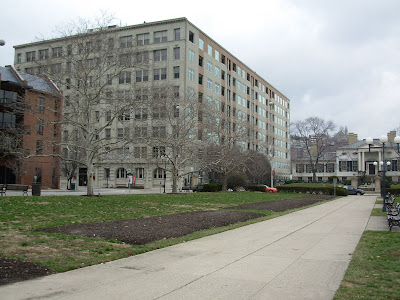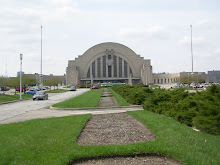Top 6 answers on the board . . .
1. 4th & Walnut Streets
Significant buildings include Fourth & Walnut Centre (1903; Addition 1920), Dixie Terminal (1921), Bartlett Building (1901; Addition 1914), Formica Building (1971) and Mercantile Library Building (1905).

2. 8th & Plum Streets


2. 8th & Plum Streets
Significant buildings include St. Peter-in-Chains (1845), Plum Street Temple (1866), and City Hall (1893). 802 Plum was built in 1945 and replaced the Temple Court Building (1870).

3. 7th & Race Streets


3. 7th & Race Streets
Significant buildings include Shillito Place (1878; Renovation & Addition 1938), The Groton (1895; Addition 1925), Pearl Market Bank Building (1910), and Jewelers Exchange (1915).

4. Garfield Place & Elm Street


4. Garfield Place & Elm Street
Significant buildings and structures include Covenant First Presbyterian (1875), The Waldo (1891), The Gramercy (1992), The Greenwich (1995), and Piatt Park with William Henry Harrison Statute (1896).

5. 8th & Broadway Streets


5. 8th & Broadway Streets
Significant buildings include Times Star Building (1933), 320 East 8th (1925), East 8th Apartments (1904) 332 East 8th (1920), 333 East 8th (1913), Gilbert Building (1915).

6. 4th & Vine Streets


6. 4th & Vine Streets
Significant buildings include Ingalls Building (1902), German National Bank (1904), Central Trust Tower (1913), and Provident Bank Building (1967).
 I wanted to document what I thought were our best corners downtown or those intersections that had a real sense of place and urbanity to them. I did not include Fountain Square (5th & Vine Streets) in the evaluation as I thought it had an inherent advantage over all others. That said though buildings like the Westin (1981) and Fountain Square West (1997) are not all that great from a design perspective.
I wanted to document what I thought were our best corners downtown or those intersections that had a real sense of place and urbanity to them. I did not include Fountain Square (5th & Vine Streets) in the evaluation as I thought it had an inherent advantage over all others. That said though buildings like the Westin (1981) and Fountain Square West (1997) are not all that great from a design perspective.

 I wanted to document what I thought were our best corners downtown or those intersections that had a real sense of place and urbanity to them. I did not include Fountain Square (5th & Vine Streets) in the evaluation as I thought it had an inherent advantage over all others. That said though buildings like the Westin (1981) and Fountain Square West (1997) are not all that great from a design perspective.
I wanted to document what I thought were our best corners downtown or those intersections that had a real sense of place and urbanity to them. I did not include Fountain Square (5th & Vine Streets) in the evaluation as I thought it had an inherent advantage over all others. That said though buildings like the Westin (1981) and Fountain Square West (1997) are not all that great from a design perspective. I did not include any intersections that had one or more open lots. That ruled out a number of possibilities, including some on Main Street which had a open corner at 7th, 8th and 9th Streets.
I did not include any intersections that had one or more open lots. That ruled out a number of possibilities, including some on Main Street which had a open corner at 7th, 8th and 9th Streets.Honorable Mentions include 4th & Broadway Streets, 4th & Pike Streets, 6th & Main Streets, and Court & Vine Streets. A number of intersections would improve greatly with new infill on the open corners. For instance 9th & Race Streets would rocket on to the list as long as the new building was at least half-way decent. Same might be said for those corners on Main Street.


As a related aside, if you have never looked at the Cincinnati Roads website, take a look. It is a great capsule of our Downtown, Mt. Adams, and Over the Rhine streetscapes. How interesting it will be to look back at those streets in ten, twenty-five, or fifty years.
.jpg)

8 comments:
Thanks for the guide, Dan. Helpful to a newcomer to Cincinnati. Though we had always lived pretty much in downtowns in our past cities and think of ourselves as more urban than not (prefer walking to driving, at minimum), we were warned away from buying and living downtown when first we moved here. Stuff like this of yours helps fill in the gap of what we don't otherwise experience on a regular basis.
I live right on the north edge of downtown and downtown is a great place to live in my opinion. Some may not like it but it suits me and many others (over 4200 people currently) well. Welcome!
Fourth and Walnut for me.
I used to work in the Fourth and Walnut Centre and it remains one of my favorite, lesser-known buildings Downtown.
I'm partial to 7th and Race since the Groton was the first place I lived in Cincinnati. I probably would have grown old and died there if it wasn't for Ms. 5chw4r7z.
Love the view walking west on 7th from Vine and looking at the Shillito, it reminds me of what they said the future would look like back in the 50's, Metropolis like.
The Shillito is retro futuristic I guess.
Harry Weese, architect for what is now the Mercantile Center but was originally the Formica Building, was very respectful not only of the adjoining Mercantile Library Building, but of Burnham's First National Bank Building, now the Fourth and Walnut Centre, as well as the Dixie Terminal and the Union Trust Buildings. It truly is a fine corner.
I went with 4th & Walnut, but if Garfield & Elm were a little more vibrant and/or aesthetically pleasing I might have gone with that.
Gotta go with my home corner of 7th and Race.
Ok, I'd like to ask if it is ok, that if you voted for "Other" please let us know by comment what you think is the best.
Thanks for all the votes and responses so far. This poll is actually a test for the upcoming March(itecture) Madness!
Post a Comment